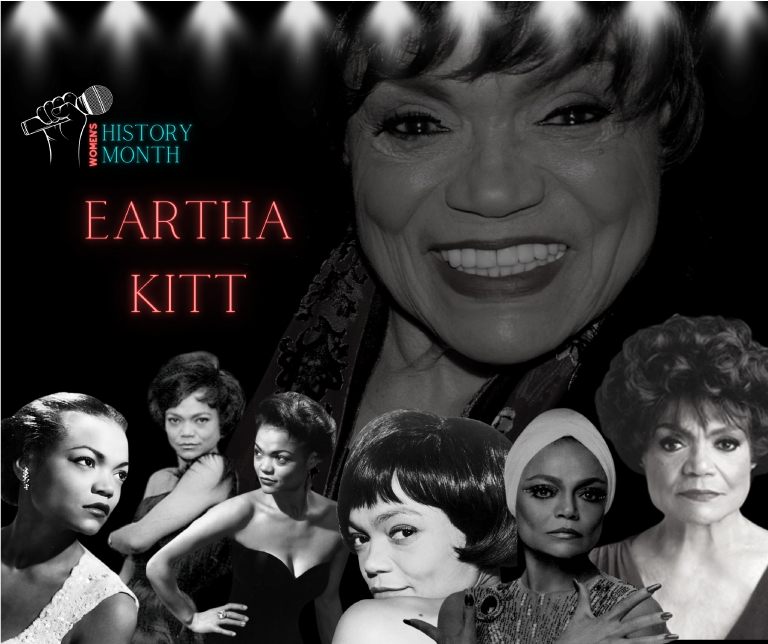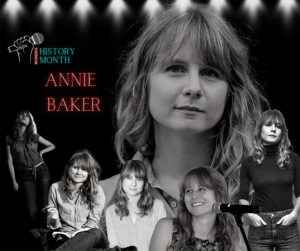Tragically if liberatingly untethered by the expectations of adults from an early age, Eartha Kitt was able to realize talents, potentials, and lay claim her own sexuality in ways that were unheard of for her peers and continue to be out of reach for many people to this day.
Ironically, Eartha was a popular Puritan name in the 1600s. Unironically, it means worldly. Kitt performed in over 100 countries and sang in 10 languages. In any language, to hear her voice is to immediately recognize her sultry style.
“I was a free spirit to do as I pleased — no one to answer to, so there is no one to hurt.”
Eartha Kitt
A professional dancer starting at age 16, she considered movement and nutrition expressions not only of self-care, but of self-love. At 5′ 2″, her svelte, curvaceous body fit every stereotype of a what it meant to be a sensuous woman in every single era of her lifetime.
Kitt was born on Mon., Jan. 17, 1927, on the St. Matthew’s cotton plantation in South Carolina to 14-year-old Annie Mae Riley, a young woman of of African and Cherokee Native American descent. The only thing that is known about her biological father is that he was Caucasian, reportedly of German descent, and was supposedly a son of the owner of the farm where she had been born. When Kitt was four years old, her birth-mother’s boyfriend insisted that she “give” Kitt to her Aunt Rosa because he didn’t want a “yellow” child in his house, the offensive racial slur “yellow” meaning a child with mixed heritage and/or lighter skin. Neglected and abused, both physically and sexually by Aunt Rosa’s teenage sons, Kitt often sought safety hiding under the beams of her aunt’s house. After Annie Mae died in 1935, Kitt, now 8 years old, was sent to live with Annie’s sister, Mamie Kitt, in Harlem, New York. She later came to believe that Mamie, not Annie, was her biological mother.
Once in Harlem, the abuse and neglect continued. “She was a child abuser,” Kitt told Veronica Webb in Interview. “I never knew when she was going to pick up a stool and hit me over the head with it. Not because I was doing anything wrong… I went to school with black eyes and welts on my bottom, and I figured, ‘Well, I guess that’s the way it was meant to be.'”
“I am an orphan, but the public has adopted me, and that has been my only family.”
Eartha Kitt
To escape Mamie’s abuse, Kitt frequently stayed with friends she met at school, and it was at school where, for the first time, adults saw both her and her talents for the special gift they actually were. With the encouragement and assistance of her teachers, Kitt won a place at the Metropolitan Vocational High School, later renamed the High School of Performing Arts. She attended school until dropping out in 1942, at age 15, to work in a factory sewing military uniforms. That, easily, could have been the rest of her story if not for chance encounter.
Katherine Dunham, an anthropoligist and artist, founded the first African-American modern dance company, the Katherine Dunham Dance Troupe, later called the Katherine Dunham Company, in 1940. On an ordinary day in 1942, Kitt was approached by a woman who asked her for directions to Max Factor’s makeup shop. Reportedly, Kitt asked why someone who was so naturally pretty needed makeup, at which point the woman explained that she was on an errand for Dunham. Exchanging directions for audition information, Kitt won a spot with the troupe and, by 1947, was a featured dancer and vocalist with the touring the United States, Mexico, South America, and Europe. She appeared in the movie Casbah in an uncredited role as a “Katherine Dunham Group Dancer” in 1948 – her first appearance on film if uncredited at the time.
While performing in Paris with the Katherine Dunham Dance Troupe, she was spotted by Jacques Sicre, the own of Le Carroll’s, a chic cabaret at 36 Rue de Ponthieu, Paris, near the Champs-Elysees, and managed by Marlene Dietrich’s former lover Frede Baule. When the Katherine Dunham Dance Troupe returned to the United States, Kitt remained in Paris where she refined her sultry “sex kitten” persona at her 11-month engagement at Le Carroll’s. It was there that she was seen by Orson Welles, who famously referred to her as “the most exciting woman in the world.”
Welles went on to cast Kitt in her first starring role on stage as Helen of Troy in his stage version of Doctor Faustus in 1950, beginning her lifelong love of live theatrical performances. Other stage credits include New Faces of 1952, Mrs Patterson (1954), Shinbone Alley (1957), Timbuktu (1978) and Blues in the Night (1985).
Still passionate about vocal performance, Kitt continued to record albums throughout her career. Some of her most well-known songs include:
- Monotonous (1952)
- Let’s Do It (Let’s Fall in Love) (1953)
- C’est Si Bon (1953)
- Santa Baby (1953)
- Nothin’ for Christmas (1955)
Kitt has 72 acting credits across film and television. Her film credits include: New Faces (1953), The Mark of the Hawk (1957), Anna Lucasta (1958), Saint of Devil’s Island (1961), Synanon (1965), The Chastity Belt (1971), Fatal Instinct (1993), Harriet the Spy (1996), The Emperor’s New Groove (2000), and Holes (2003). Her most well known television credit is as Catwoman in Batman, a role she took over in the series’ third and final season after Julie Newmar left in 1966.
It was shortly after that, at what was arguably the height of her career, when Kitt was invited to a women’s luncheon at the White House, hosted by Lady Bird Johnson. The topic? “Why is there so much juvenile delinquency in the streets of America?” Initially, Kitt turned down the invitation – suspect of a set up. After being personally contacted by Johnson’s social secretary, however, she reconsidered and went prepared for a substantial discussion. It was, unfortunately, as she had feared — a trite, surface-level photo-op with 50 other women. Nearing the end of the event, Johnson asked the women for their comments. Kitt, a lifelong activist and advocate for multiple causes and never one afraid to speak truth to power, said, “boys I know across the nation feel it doesn’t pay to be a good guy. They figure with a record they don’t have to go off to Vietnam. You send the best of this country off to be shot and maimed. They rebel in the street. They will take pot and they will get high. They don’t want to go to school because they’re going to be snatched off from their mothers to be shot in Vietnam.”
In addition to bringing Johnson to tears, that honest response got her blacklisted from performances venues in the United States. In addition, it was later uncovered by the New York Times that the CIA, prompted by the U.S. Secret Service in 1968, began keeping a dossier on her. In spite of her views aligning with the growing number of United States citizens objecting to the war in Vietnam, Kitt could not find work in the United States and ended up focusing on performances in Europe and Asia until her return to the United States in 1974.
“The price we pay for being true to ourselves is worth it.”
Eartha Kitt
In addition to her work on stage, screen, and recording careers, Kitt penned three autobiographies and a fitness book – her first, Thursday’s Child (1956), inspiring David Bowie’s song of the same title. Her other books include:
- Alone with Me (1976)
- I’m Still Here: Confessions of a Sex Kitten (1989)
- Rejuvenate! (It’s Never Too Late) (2001)
“I have never yearned to stay young, but rather to stay me. The me committed to embracing her uniqueness. The me who feels no shame in championing and cherishing herself. The me who accepts aging as a natural process, not a disease, and who says ‘Thank You Thank You’ when I take care of myself.”
Eartha Kitt
Kitt was married once to William O. McDonald, a real estate developer, on June 6, 1960. Though their marriage was short-lived, ending in divorce on March 26, 1964, they had a daughter, Kitt, on Nov. 26, 1961. Kitt [McDonald] Shapiro writes a blog, simplyeartha.com, where she shares stories about her life with her mother.
Kitt famously said that “the present without a past has nothing to say for itself.” Her present spoke volumes.
Kitt passed away on Christmas day in 2008. Shapiro was with her.
Eartha Kitt rightfully should have never survived the multiple traumas of her childhood. How quaint Johnson’s upset must have seemed to a woman who once prayed for invisibility due to starvation and neglect. Kitt declared that her flaws made her who she was, and who she was a breathtaking force and example of self-actualization for women all over the world.
“When she left, she left the world with a bang. She left it how she lived it.”
Kitt Shapiro



![Read more about the article Kilroy is Her[e]](https://stagecoachplayers.com/wp-content/uploads/2021/03/The-Kilroys-simple--300x251.png)
